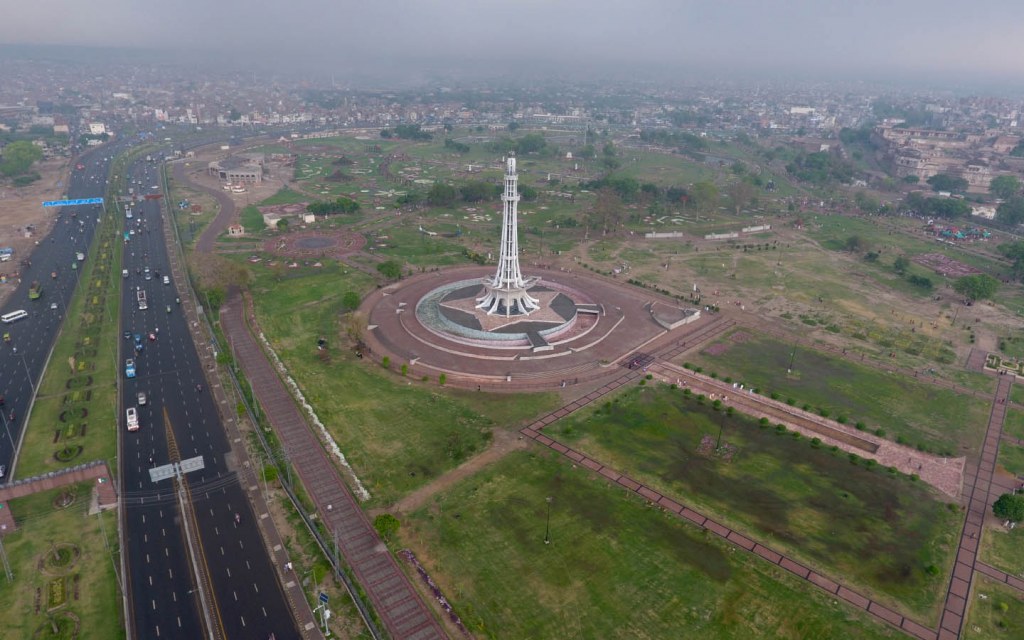Minar-e-Pakistan, also known as the ‘Tower of Pakistan,’ was built with a purpose—to commemorate the Lahore Resolution. Qarardad-e-Pakistan was passed in an All India Muslim League session on March 23, 1940. It was held at Minto Park – now renamed as Iqbal Park. The nation celebrates this momentous occasion as Pakistan Day and the government of Pakistan announces it as a public holiday every year. For any patriotic citizen of Pakistan, the history of Minar-e-Pakistan holds great importance.
Significance of Minar-e-Pakistan
There is a historic moment behind this tall tower in Lahore. The Pakistan Resolution cemented the way for a separate state of the Muslims of India.
So, what events paved the way for Qarardad-e-Pakistan? Up until the mid-1930s, the Muslim leaders were making efforts to safeguard the political interests of Muslims within India and wanted Muslim-majority provinces to have maximum autonomy.
History of Minar-e-Pakistan
In the 1935 Government of India Act, it was decided to have communal representation through separate electorates. When elections were held under this Act, Indian National Congress formed a government in six out of eight provinces. During the rule of the Indian National Congress from 1937 to 1939, it was apparent that Muslims were sidelined and Congress leadership completely failed to represent Muslims.
Lahore Resolution
By 1939, the thought of a separate nation was gaining popularity among Muslim leaders. The All India Muslim League held a session from 22 to 24 March 1940 at Minto Park. The Pakistan Resolution was moved by A.K. Fazl-ul-Haq, who was the Chief Minister of Bengal. It was seconded by Sardar Aurangzeb Khan from N.W.F.P., Zafar Ali Khan from Punjab, Chaudhry Khaliq-uz-Zamaan from United Provinces, Qazi Muhammad Essa from Balochistan and Sir Abdullah Haroon from Sindh.
March 23, 1940, is marked as a day when Muslims demanded a separate homeland. It reiterated Allama Iqbal’s presidential address held at Allahabad in 1930, where he shared his vision of a separate homeland for the Muslims of India. The Lahore Resolution categorically demanded Muslim majority areas of north-eastern and north-western zones of India be grouped as an independent state.
The Lahore Resolution gave new hope to the Muslim community in India. The struggle to have a sovereign state gained momentum and after seven years, Pakistan came into existence on August 14, 1947. To honour the place where the Pakistan Resolution was passed, a tower was constructed in Greater Iqbal Park, laying its foundation stone on March 23, 1960. It took eight years to construct the tower and in 1968 this historical building in Lahore was built.
Architecture of Minar-e-Pakistan

Minar-e-Pakistan is not only an important landmark in Pakistan, but it also symbolizes Islamic and Mughal architecture with a touch of contemporary design. The architect of Minar-e-Pakistan was Naseer-ud-din Murat Khan.
The base of the minaret is 8 meters high from the ground and the towering structure is built 62 meters above a star-shaped base. This makes it a total of 70 meters above the ground. It has a beautiful design as if the petals of a flower are unfolding. Minar-e-Pakistan has a diameter of about 9.75 meters.
Construction having symbolic representation
The base consists of four platforms and symbolizes the freedom struggle. The first platform is created with uncut and unpolished stones from Taxila, representing the hard, unrelenting efforts of Muslims of India in the freedom struggle.
The second platform is built using hammer-dressed stones, reflecting the coarse and rough path towards freedom while the third platform is made of chiselled stones, representing how the Pakistan Movement gained momentum. At the fourth platform, polished white marble is used – depicting the success in the existence of Pakistan.
Cost of construction
The total construction cost incurred on the project was approximately PKR 7,058,000. Due to a lack of resources, funds were raised at the request of Governor West Pakistan, Akhtar Hussain. Additional taxes were levied on watching movies in cinema houses and also on people who bought tickets to horse-racing events.

Today, Minar-e-Pakistan stands tall in the centre of Iqbal Park, entertaining its visitors with panoramic views of the city. People who can’t climb the stairs or reach the top of the building can do so by means of an elevator. There is a huge park, an artificial lake and gurgling fountains around it that make it all the more alluring.
Inscriptions inside Minar-e-Pakistan
There are inscriptions inside the building. The Lahore Resolution in text form is inscribed on the stone wall of Minar-e-Pakistan. It is written in different languages: English, Urdu, Bengali and even Arabic.
On different panels, using calligraphy, verses from the Holy Quran and the 99 names of Allah are engraved whereas the National Anthem of Pakistan is also carved in Bengali and Urdu. You will also find excerpts from the speeches of Mohammad Ali Jinnah in Bengali, English and Urdu. Some of the famous couplets of Allama Iqbal are also inscribed on the walls.
Tomb of Hafiz Jalandhari
The resting place of Hafiz Jalandhari, who wrote Pakistan’s National Anthem is located in the courtyard of Minar-e-Pakistan. The tomb of Allama Iqbal is also located in Iqbal Park. Some of the most important historical buildings in Lahore like Badshahi Masjid, Lahore Fort and Sheesh Mahal are adjacent to Iqbal Park. Entrance is free and people from all over Pakistan visit Minar-e-Pakistan to pay tribute to the freedom fighters.
If you want to learn more about Pakistan’s history then you can check out some of these historical buildings in Karachi, too. And if you like reading about ancient sites, take a look at some of the most popular historical locations in the world.
For more information on national monuments, please stay tuned to Zameen Blog – the best travel and tourism blog in Pakistan. In addition, you can share your thoughts and comments with us by dropping an email at blog@zameen.com.



